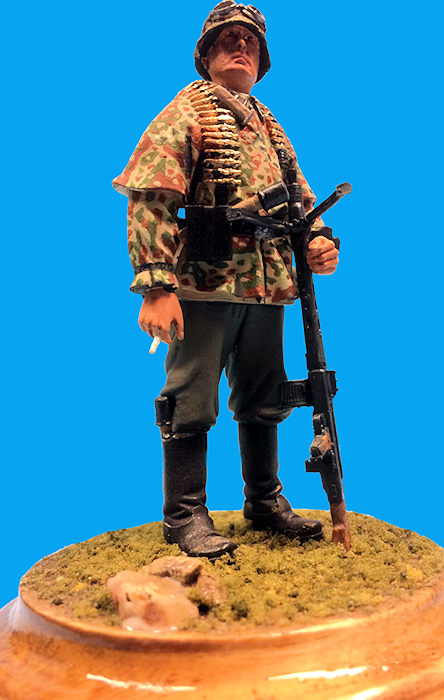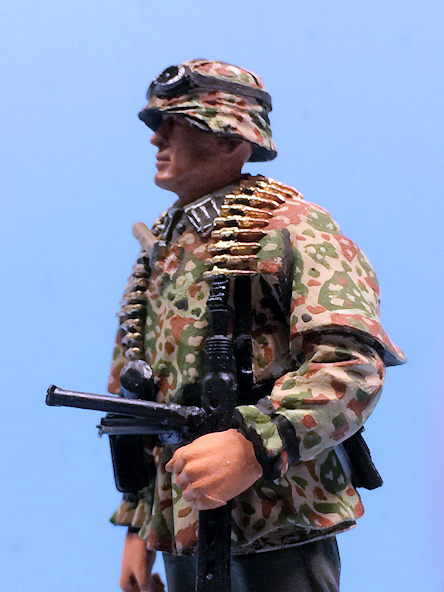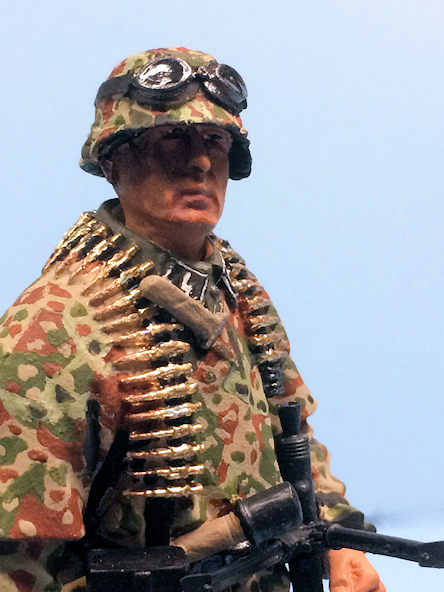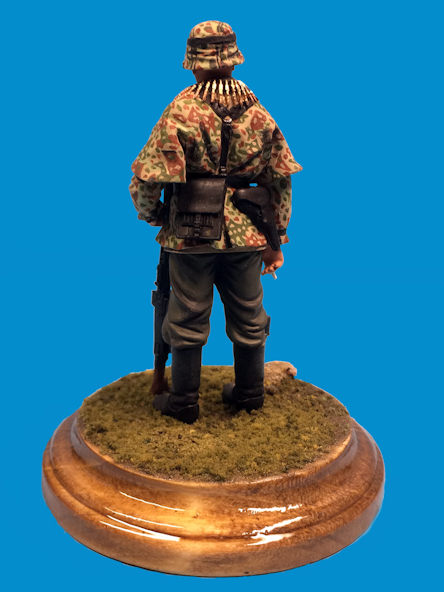
Verlinden 120mm German Machine Gunner
| KIT #: | 2404 |
| PRICE: | @$20.00 |
| DECALS: | N/A |
| REVIEWER: | Blair Stewart |
| NOTES: | Optional head included |

| HISTORY |
World War II saw the proliferation of machine guns and their heavy integration into infantry units. Both the Axis and Allied powers included machine gun teams in their armies. Indeed, machine gun teams were integral down to and including the platoon level.
In the German Army, the Maschinengewehr 42 (MG42) was one of its mainstays. The MG 42 is a 7.92×57mm Mauser general purpose machine gun designed in Nazi Germany and used extensively by the Wehrmacht and the Waffen-SS during the second half of World War II. It was intended to replace the earlier MG 34, which was more expensive and took much longer to produce, but the German war industry produced both weapons until the end of the war.
The MG 42 had a proven record of reliability, durability, simplicity, and ease of operation, but it is most notable for its ability to produce a high volume of suppressive fire. The MG 42 had one of the highest average cyclic rates of any single-barreled man-portable machine gun: between 1,200 and 1,500 rpm, resulting in a distinctive muzzle report comparable to the sound of a power saw or tearing linoleum.
The MG 42's lineage continued past Nazi Germany's defeat, forming the basis for the nearly identical MG1 (MG 42/59), chambered in 7.62×51mm NATO, which subsequently evolved into the MG1A3, and later the Bundeswehr's MG 3. It also spawned the Swiss MG 51, Zastava M53, SIG MG 710-3, Austrian MG 74, and the Spanish 5.56×45mm NATO Ameli light machine gun, and lent many design elements to the American M60 and Belgian MAG. The MG 42 was adopted by several armed organizations after the war, and was both copied and built under license.
| THE KIT |
 After a number of aircraft kits (primarily 1/32 scale built with
my 5-year-old grandson to hang from the ceiling of his room), I once again found
myself with the early stages of AMS (advanced modeler’s syndrome for the novices
out there), so I needed to shift gears. My answer was my recently acquired
“sweet spot” of hand-painted figures, so I went to my stash to find an
interesting kit. After seeing its pose, I opted for this kit of a WWII German
machine gunner taking a smoke break.
After a number of aircraft kits (primarily 1/32 scale built with
my 5-year-old grandson to hang from the ceiling of his room), I once again found
myself with the early stages of AMS (advanced modeler’s syndrome for the novices
out there), so I needed to shift gears. My answer was my recently acquired
“sweet spot” of hand-painted figures, so I went to my stash to find an
interesting kit. After seeing its pose, I opted for this kit of a WWII German
machine gunner taking a smoke break.
Verlinden’s 120mm resin kits always exhibit a high degree of detail, and most offer interesting “poses” for the assembled figures. This kit consists of 24 pieces plus an optional head. Although the box is not labeled as such, the SS insignia on the figure’s collar clearly indicate that this is a Waffen SS machine gunner. In addition, the figure is wearing the SS camouflage smock readily seen in a number of World War II photos. In addition, the kit includes a full complement of German infantry equipment, including two “potato masher” grenades and a knife/dagger that can be placed at the ready in the gunner’s tunic.
| CONSTRUCTION |
As usual, one must separate the parts from their resin casting blocks, and I do this using a razor saw and an Xacto knife. Some of the parts such as the legs and torso require sanding to help them mate more smoothly when gluing. Once I removed the casting blocks, I used the Xacto knife to clean up any casting seams and/or resin flash on the castings. I used Super Glue to assemble the figure and its equipment, and then Mr. Surfacer 1000 to fill and smooth seams.
| COLORS & MARKINGS |
 The photograph on the kit’s box shows the figure in one of many
Waffen SS camo schemes. I went on line and found a billion pictures of Waffen SS
camo and a seemingly equal number of schemes (it seems tanks were not the only
things of which the Germans produced a lot of variants!). I first painted the
smock in a splinter pattern, but then decided it was too plain looking, so I
modified it to reflect an ambush pattern like those seen on German armor towards
the end of the war.
The photograph on the kit’s box shows the figure in one of many
Waffen SS camo schemes. I went on line and found a billion pictures of Waffen SS
camo and a seemingly equal number of schemes (it seems tanks were not the only
things of which the Germans produced a lot of variants!). I first painted the
smock in a splinter pattern, but then decided it was too plain looking, so I
modified it to reflect an ambush pattern like those seen on German armor towards
the end of the war.
I spray painted the figure with a coat of Testors enamel flat white. As is my practice, I primarily used a variety of relatively inexpensive acrylic craft paints to apply (note: I find Testors enamel better for the metallic colors such as the gunmetal of the MG42 and the gold and brass cartridges).
Once I was satisfied with the figure’s paint scheme, I then mounted it on a round, wooden display base I purchased at Hobby Lobby. I finished the base with Watco finishing oil and then coated it with Rustoleum Crystal Clear out of a rattle can. I then laid on a coat of white glue on the base’s surface, and then sprinkled sifted fine dirt to form a ground base. On top of this, I added some small rocks I collected from outside and then sprinkled Woodland Scenics coarse turf on top of the dirt base to simulate some vegetation.
| CONCLUSIONS |
 This is another nice kit from Verlinden. It was a
great change of pace for me, and I highly recommend it to anyone who enjoys
modeling military or other figures.
This is another nice kit from Verlinden. It was a
great change of pace for me, and I highly recommend it to anyone who enjoys
modeling military or other figures.
| REFERENCES |
MG 42, Wikipedia, December 2016.
“Handbook on German Military Forces, - TM-E30-451,” US Government Printing Office, Washington, DC, 1945.
Blair Stewart
23 January 2017 Copyright ModelingMadness.com If you would like your product reviewed fairly and fairly quickly, please contact the editor or see other details in the
Note to
Contributors. Back to the Main Page
Back to the Review
Index Page
Back to the Previews Index Page